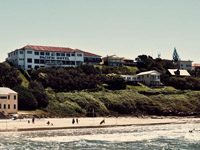
Under pressure tourism chiefs defend taxpayer-funded trip
WA tourism has defended a decision to take 40 social media influencers on a taxpayer-funded getaway as part of its tourism marketing strategy.
The mix of actors, surfers, models and media presenters from 11 different countries, boasting a combined social media reach of 28 million, joined state tourism minister Paul Papalia on the recent five-day trip to The Kimberley.
While Tourism WA and Tourism Australia have not revealed the cost of the trip, which was co-hosted by GoPro, Mr Papalia told the ABC: “It was a pretty minimal cost.
“We don’t reveal individual costs of that nature, but I can tell you what we spend on influencers in a year, and that’s less than one percent of our marketing budget which is $45 million.
“Tourism WA will do analysis and try to determine the return in terms of people booking and making a decision as a consequence.
“But you’ve got to remember that we don’t rely on this … there are a whole range of activities dedicated to selling WA to the world, and this is just part of that, and it’s only just a small part.”
The debate coincides with calls from Tourism Council WA for the government to commit to a target of creating 6,000 WA tourism jobs each year, in a push to achieve the same levels of growth as other states.
While the council has welcomed Tourism Research Australia’s latest figures showing WA added around 2,000 tourism jobs in 2017-18, it says the state is still underperforming.
Western Australia had the lowest tourism jobs growth of any state or territory at 1.8 per cent, well below the national growth figure of 5.3 per cent.
“If WA tourism had grown at the same rate as Australia, 5,700 new jobs would have been created across the State,” the organisation’s CEO Evan Hall said.
“Western Australia’s falling market share in international tourism is the main barrier to growing tourism jobs for local people.
“The state government has committed additional funding to boost international marketing and attract more international visitors, and this should soon begin to bear fruit.
“The state government should aim to grow tourism jobs at the same rate as the rest of Australia and commit to a target of 6,000 new tourism jobs per annum.”
Latest figures show tourism is responsible for 108,000 full-time jobs in Western Australia representing more than eight percent of the state’s workers – a higher percentage than are employed in the mining industry.
The government argues influencers are a part of marketing WA to a worldwide audience – including the 100,000 Instagram followers of 18-year-old pro surfer Pacha Light, who was part of the contingent to The Kimberley.
She told the ABC: “It really starts to create this unison with everybody. Everybody’s got the same interests in the ocean and nature and having fun and spreading that stoke and awareness … it just feels like there’s a community out there.”
It is believed none of the Instagram influencers engaged were paid for the trip, but their accommodation, transport and tours were funded by the government.
Tourism Australia says thorough evaluations are done of all taxpayer-funded digital campaigns and influencer contracts.
A campaign featuring actor Chris Hemsworth, worth a reported $1.25 million over two years, involved outback images broadcast to his Instagram audience of more than 30 million.
Tourism Australia says it resulted in more than 9,000 media articles promoting Australia which were viewed more than 19 billion times with an estimated value of $204.3 million.

AccomNews is not affiliated with any government agency, body or political party. We are an independently owned, family-operated magazine.








Good article Kate but it is really only the tip of the ice berg about “Where and how is our marketing money being spent?”.
The current marketing activities of TourismWA and the RTOs need a good review covering areas such as: Return on Investment (ROI), how marketing campaigns are structured, and what is the actual need and purpose of a campaign. From what I can see, most of the marketing activities are quick and short advertising spurts, where there is no sustained follow up marketing campaign and the ROI is dubious at best, if it can be measured. Feedback to operators about campaigns success is often bland and too broad to be meaningful.
From basic Marketing 101 principles, marketing events and activities need to answer, as a minimum, two basic questions before they are approved – Firstly, is a viable ROI going to be achieved from the event /activity /campaign and secondly and most importantly, would you spend money on the event /activity /campaign if the money was coming out of your own pocket?
But back to the GoPro Event. We are a Kimberley based hospitality business and there was no direct or indirect communication with us about how we could integrate with and leverage off this GoPro event. This is pretty disappointing as marketing can be so much more effective when it is done collaboratively with the onground operators, regardless of whether it has a high or low spend. The GoPro event appears to be little more than a photo opportunity for the organisers and a chance to promote the Brand of the Influencers, more than effective destination marketing.
As far as I am aware there was no Call to Action or a dedicated website that people are directed to once they have viewed the footage. Nor is there any mechanism to obtain potential visitor’s details (eg email address) so that an onoing dialogue can be maintained with people as they move through the marketing funnel. These are all basic marketing techniques in the digital world.
“Tourism WA will do analysis and try to determine the return in terms of people booking and making a decision as a consequence.” Given that there is apparently no trackable Call to Action it will be interesting to see the results and what the ROI was for this or many of the advertising activities that these organisations are conducting.
The GoPro event may have been on a low budget and commendations for that, but high and low spend marketing activities have all been following the same suit of late, instead of getting back to marketing basics.
This article should be a great conversation starter on marketing issues, is our marketing money really being used effectively and who is being held accountable for it?